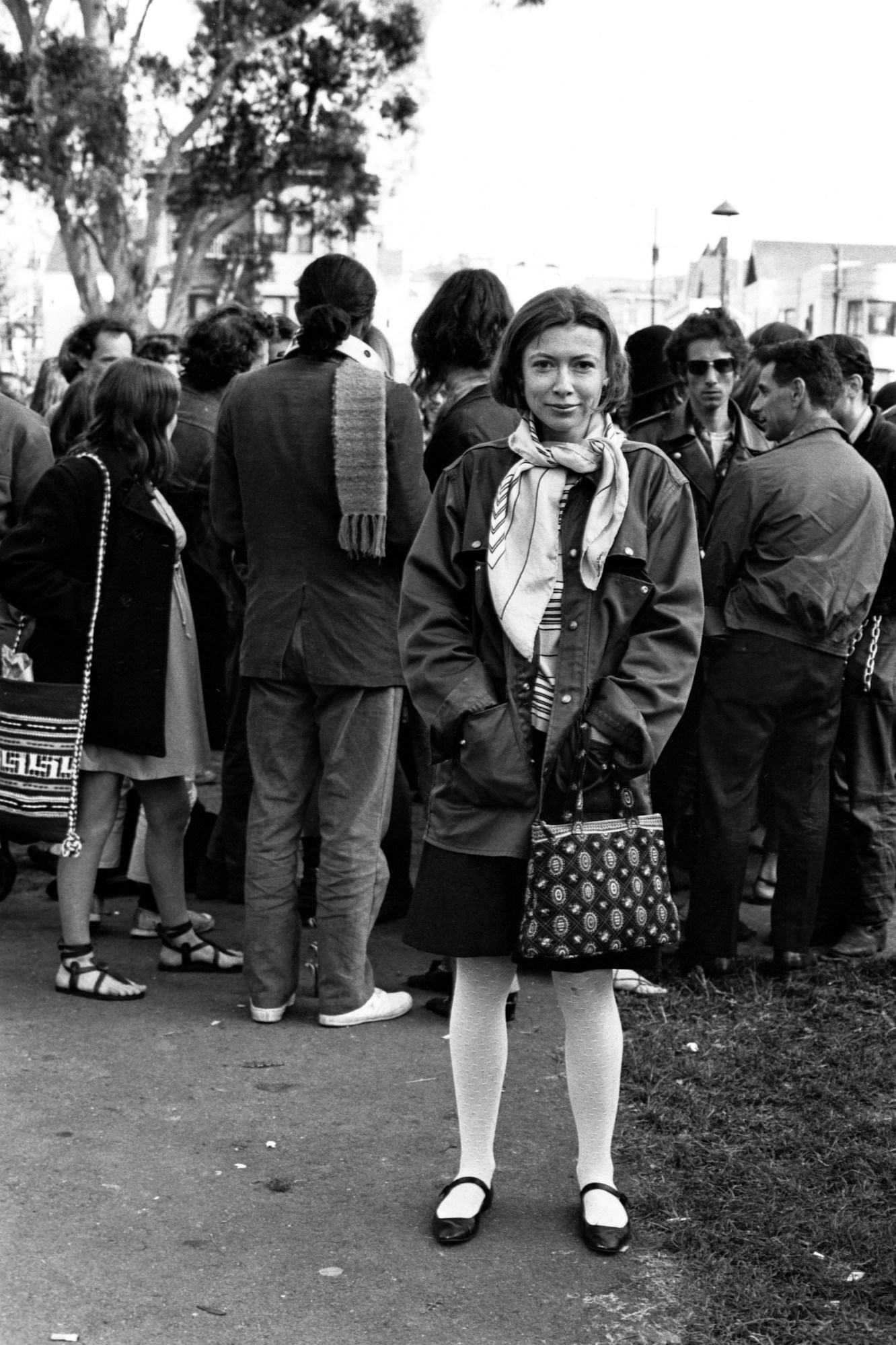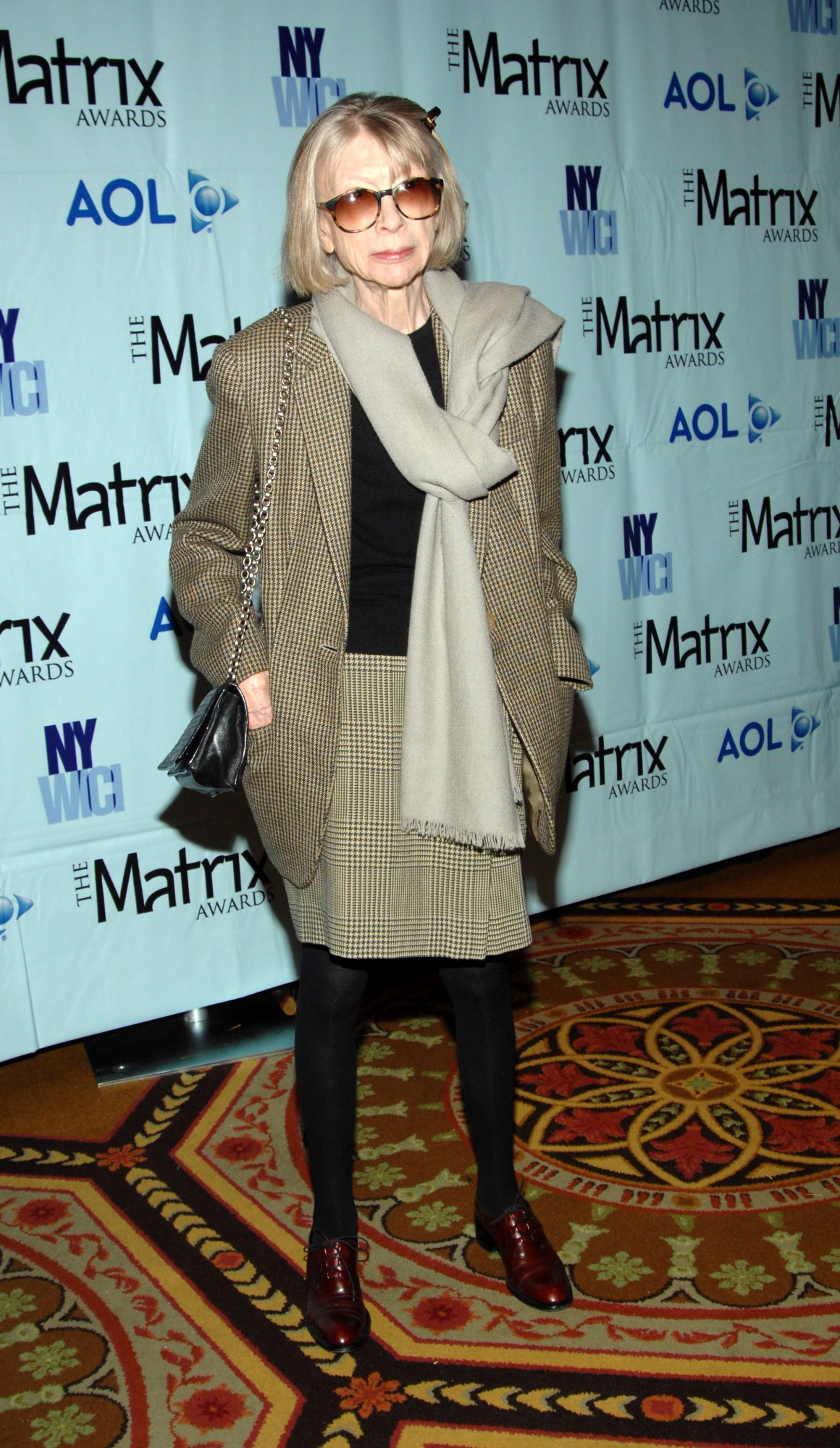In 2020, one year before her passing, Joan Didion answered a series of stock questions that Andy Warhol used to ask his interviewees. Didion’s response to Warhol’s question, “Why can’t it be magic all the time?” is a blunt and incredulous, “What?” This now infamous exchange seems to underscore the difference between these two artists. Both helped define America in the 60s and both adopted a uniform-like aesthetic that cemented their public image, yet here Warhol is cast as the childlike fantasist while Didion is practical and rational in her worldview.
Didion took a similarly no-nonsense approach to fashion. The writer, reporter, essayist and screenwriter’s sparse prose depicting grief, unrest and ennui have inspired not only the minds of her disillusioned, literary-minded readers, but also their wardrobes. When Warhol asks “What clothes do you like?” Didion responds, “I like big sweaters, pants, long skirts – loose, casual, comfortable clothes.” And, as Didion was one of the most photographed writers of the 20th century, there are reams of iconic images to support this statement.
You can see it when she’s nonchalantly leaning against her new Corvette in a long sleeved jersey dress and flip flops. Or when she’s at home wearing a plain T-shirt over a paisley sundress. Or fronting a Céline campaign aged 80 in her perennial oversized black shades. Didion’s personal style has helped make her the archetypal intellectual cool girl and this, as much as her sparse, ironic prose, is why everyone still loves to show off that they’re reading her books by posting them on Instagram and TikTok.
Here, we look back at some of Didion’s most iconic outfits — from the 60s all the way through to the 2010s.
Leaning against her Corvette, 1968
It’s the image of Joan Didion that’s burned into the popular imagination. Here, a 34-year-old Didion leans coolly against her new Corvette Stingray wearing a simple jersey dress and flip flops, hair mussed, cigarette dangling from her fingers. It sums up her straightforward approach to fashion which prioritised comfort and Californian ease. The photograph was taken by Julian Wasser the year that Didion released her seminal book of essays, Slouching Towards Bethlehem, the book that would launch her to new levels of fame. In the photo, the car appears white, but it was actually banana yellow, so thank god for black and white photography, otherwise this image might not be so chic. In 2017, this photograph would become the cover of Terry Newman’s book, Legendary Authors and the Clothes They Wore, a testament to its lasting legacy as the definitive image of the stylish author.
The Céline campaign, 2015
When Joan Didion became the surprising new face of Céline at the age of 80, the internet went into a frenzy. But it wasn’t only a surprise to her fans. Not even Didion’s friends and family knew the campaign was happening — she posed alone at home with only Juergen Teller and Phoebe Philo present. This reticence to tell people about the campaign reflects her humble, low-key attitude that made its presence felt in her wardrobe too. When The New York Times called her up to ask her what she made of everyone losing their minds over the campaign, she responded with, “I don’t have any clue. I have no idea.” Here, she wears a simple ribbed roll neck, oversized black shades and a gold pendant – cold, hard proof that looking achingly cool has no age limit.

The GAP campaign, 1989
Céline was not the first time Joan Didion had starred in a fashion campaign. In 1989, she posed with her then 23-year-old daughter, Quintana. It was shot by Annie Leibovitz and, in it, the mother and daughter wear matching black turtlenecks as part of GAP’s ‘Individuals of Style’ campaign. It later appeared in a 2007 exhibit at the National Portrait Gallery. Sadly, Quintana passed away in 2005, aged 39. In Blue Nights, Didion’s deeply moving 2011 memoir about losing her daughter, she writes, “I can now afford to think about her. I no longer cry when I hear her name. I no longer imagine the transporter being called to take her to the morgue after we left the ICU. Yet I still need her with me”.
At home with her daughter, 1960s
Joan Didion started her career at Vogue in the 1950s after winning a writing competition while she was at college. It’s no wonder then that she cultivated such a strong sense of personal style. Didion’s most famous essay from her time at Vogue is called “On Self-Respect”, which was republished in 1968’s Slouching Towards Bethlehem. In it, Didion argues that “character – the willingness to accept responsibility for one’s own life – is the source from which self-respect springs.” Didion’s own character was expressed through the decisive responsibility she took for her writing, life and style. Here, she’s photographed at home with young Quintana, wearing an idiosyncratically simple outfit – a plain t-shirt thrown over a paisley sundress. It’s comfy, effortless, relaxed, and yet still full of character.

With a group of hippies while reporting for Slouching Towards Bethlehem
Even if you’ve never read a Joan Didion book, you might have seen her packing list. It was shared and reshared upon her death in 2021. But what does it tell us about Didion and the way she dressed? The list features “2 skirts, 2 jerseys or leotards, 1 pullover sweater, 2 pair shoes, stockings, bra, nightgown, robe, slippers, cigarettes, bourbon” along with toiletries and work supplies. It was taped inside her closet during her reporting years so she could be ready to go at a moment’s notice. “The list enabled me to pack, without thinking, for any piece I was likely to do,” she wrote in her 1979 book of essays The White Album. “Notice the deliberate anonymity of costume: in a skirt, a leotard and stockings, I could pass on either side of the culture.” Here, she’s reporting at the height of the hippie movement in San Francisco in 1967 wearing a silk scarf, waterproof jacket, plain black skirt, black shoes and white tights, accessorised with a handbag. It’s one of Didion’s more detailed looks and it feels more preppy than hippie. Didion loathed hippies and what she saw as their vacuous spirituality, an opinion only solidified during her reporting when she witnessed a 5-year-old on acid.

At the Women in Communications Matrix Awards, 2007
In the entry hall to her apartment, Joan Didion kept a giant bowl of sunglasses, so she was ready to slide some on and go at any moment. Didion would often wear sunglasses back in her Malibu days in the 60s, where she would sit at breakfast in silence, sipping a cold Coke and eating a pile of salted almonds. Here, she’s attending the 2007 Women in Communications Matrix Awards, where she was an honouree. She wears this tweed skirt suit with her signature nonchalant dishevelment, styled with an oversized grey scarf, chain strap black handbag, burgundy brogues and, of course, a pair of shades.
At home, wearing her Michael Kors cape
Following Michael Kors’ 1999 runway show, Joan Didion fell in love with a cape that was modelled by Naomi Campbell. Didion was later photographed wearing it in this Tina Barney portrait. Kors himself was a fan. “When I first saw the photo, I was totally knocked out,” he said. “Her brilliant writing and sense of style have always been a huge inspiration to me.” When Didion was asked what she thought of her role as a style icon in a 2021 interview with Time magazine, she responded, “I don’t know that I am one.” Her decisive, minimalist fashion attests otherwise.

